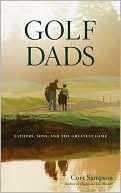Golf Dads: Fathers, Sons, and the Greatest Game
Fathers and mothers raise and love their children in different ways, I think.
If you’ll pardon a gross generalization, fathers tend to love their children by indirection, while mothers love and protect their children more directly.
For example, many fathers I know are more willing to encourage their children to try out for sports and other physically demanding tasks. They are also less likely to attempt a rescue when the child falters in these efforts, thinking in most cases that failure is often a great teacher.
Many fathers also show their love by example–by the way they work, support their families, and act when their children are in their presence, even while playing games.
Most of us don’t consciously think about our children’s remarkable powers of observation during these moments, which may be a good thing in the long run. We might be surprised at times, ashamed on occasion, and overcome with joy at other moments.
Curt Sampson brings some of that same level of scrutiny to his newest and most thoughtful book, Golf Dads (Houghton Mifflin; $22 SRP). The successful golf writer and former golf professional became inspired to write about fathers, their children, and the game after his own father passed away in 2005.
The readers learn a bit of Sampson’s own story of growing up, joining his father for his weekly early morning Saturday round, and as he puts it, becoming “a witness to the secret world of grown men.” As happens in large families, Sampson’s special time with his father caused rifts with siblings, especially after Sampson immersed himself in the sport. Apparently it remains a bit of an issue, even with his father’s passing.
The slim volume studies several other father/child sets, in a wide variety of circumstances, not all of which make for pleasant reading. For example, I don’t think Byung Wook Wie, Michelle Wie’s father, will be inviting Sampson over to the Wie household for a beer anytime soon. I’ve read elsewhere about Korean culture and its family dynamics, but this Hawaiian professor’s reported antics must set an extreme example.
Sampson drew upon his previous biography of Ben Hogan, as well as other sources, in writing about the father/son-like relationship the great golfer had with Marvin Leonard, a successful Texas businessman. Hogan’s tightly controlled mannerisms may have been his way of coping with his real father’s suicide, but Leonard clearly also had a major influence on him.
Some children show amazing sporting prowess at an early age, even if their names don’t begin with a T. Sampson studies two such cases; one is currently amazing his supportive parents with his golfing skills, and another once did. Both are fascinating stories, especially when considered together. One wonders how much the experience of the older child will be mirrored by the younger.
Other father/child stories follow a somewhat more traditional trajectory, even if the particulars vary significantly. I felt this way about the chapters on PGA Tour professional Peter Jacobsen and his family, CBS golf announcer David Feherty and his upbringing in Northern Ireland, and Jack Burke, Jr., the Masters tournament winner and owner of the famous Champions course in Texas.
Another chapter considers Lee Trevino, known far and wide for his showmanship on the course, but less well known for his at times chaotic personal life. Sampson is fairly blunt in his assessment of Trevino’s varied approach to fatherhood during his several marriages, but the Senior Tour star’s current attempts at doing right by his young son Daniel offer hope for improvement.
The last chapter is the most moving, especially considering Sampson’s inspiration for writing the book. He accompanies a Dallas golf pro to an overgrown nine-hole layout in Mexico, where the pro intends to spread his father’s ashes along the course. The course holds many happy memories for the golfer’s family, and this was a wonderful way to celebrate his father’s love.
This is a truly fine book, about far more than an old Scottish game that fathers sometimes teach their children.
Review date: July 25, 2008


